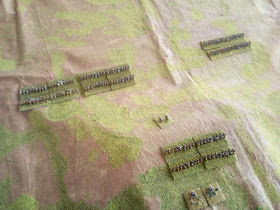Neil Thomas' rules don't specify troop ratios or ground scales or anything like that, but do give some very generic army lists. I used the following forces:
Royalist Army:
2 units of Horse (Chevaliers, Medium Armour, Elite)
2 units of Horse (Chevaliers, Light Armour, Trained)
1 unit of Artillery (but allowed to move at the same rate as Pikemen)
1 unit of Foot (3 bases of Shot, 3 bases of Pike, Light Armour, Trained)
1 unit of Foot (3 bases of Shot, 3 bases of Pike, Light Armour, Elite)
Parliamentary Army:
1 unit of Cuirassiers (Reiters, Heavy Armour, Elite)
3 units of Horse (Reiters, Medium Armour, Levy)
2 units of Foot (4 bases of Shot, 2 bases of Pike, Light Armour, Trained)
2 units of Artillery
The Set-Up:
 |
| The same terrain as previously: Parliamentarians (left) with Horse to the flanks and Foot and Guns in the centre defend Roundway Down from the approaching Royalist cavalry (right) |
 |
| And centred on the Parliamentary army: note again the road by which the Royalist infantry can/will approach |
 |
| And the view from behind the Parliamentary lines |
 |
| And closer in on the defending Parliamentarians; the Cuirassier unit is top-right. |
 |
| And a view of the Royalists approaching |
 |
| And reversed angle |
 |
| The Royalist Horse advance - one unit takes some casualties from the defending artillery |
 |
| The Royalist Horse advances; just before contact the Parliamentarian Horse advance and discharge their pistols, causing some further casualties |
 |
| Same position, looking from the Royalist side down through the Parliamentary position |
 |
| The fight gets to sword range; losses on both sides, but the Cuirassiers are coming off distinctly worse... |
 |
| On the other flank, quite even but with a slight advantage to Parliament's troopers |
 |
| A grim slow struggle on the far flank as only small remnants of the initial units are still fighting! |
 |
| On the far flank, the Parliamentary cavalry (much reduced) finally emerges victorious! The Royalist centre and right is now completely open... |
 |
| Parliamentary musketry finishes off another unit of Royalist Horse, now only a single unit remains |
 |
| The Royalist infantry approach and start taking some casualties from musket fire; the Parliamentary cavalry charge the Royalist artillery (right) |
 |
| The Royalists concede as clearly nothing can stop the Parliamentary cavalry now |
Incidentally, I can't recommend these rules highly enough to the beginner or to the fan of simple rules - they definitely give the smoother, lighter experience.
Figures by Baccus 6mm.




Thanks, From memory, I think the Thomas rules reward having a reserve (if you have that luxury). Off to look at your Polemos game now to compare.
ReplyDeleteIt does; the attritional model he uses means that fresh troops are worth their weight in gold, since they do so much more damage.
ReplyDeleteI enjoy your rules' comparisons very much. Are interested in including some additional, easy to learn rules to this study? I suggest Thomas' One Hour Wargames, Basic Baroque, and Ironsides. I compared these these three rules using the ECW Battle of Southam.
ReplyDeleteThanks very much. I won't promise anything but I will certainly have a look at the rules you suggest.
ReplyDeleteThe core of his rules are great, but only work for about 80% of on-table situations. I am constantly frustrated by having to rule on silly things like what *actually* constitutes a flank attack, and whether you can shoot through gaps and so on. I'm sure there's an intent, but I'd love to read the bits of the rules that are still in Neil Thomas's head :)
ReplyDeleteYes, agreed. I think DBA is a good contrast, in that it gets to about 99%, but the cost of doing that is much denser rules-writing; although fundamentally the game is of roughly the same complexity.
ReplyDelete